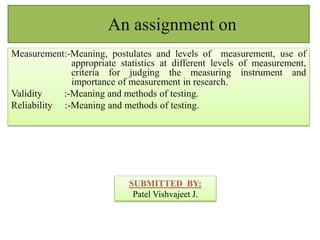This document discusses measurement, validity, reliability, and levels of measurement. It provides definitions and methods for testing validity and reliability. There are four levels of measurement - nominal, ordinal, interval, and ratio - which determine the appropriate statistical analyses. Validity is tested through content, predictive, concurrent, and construct validity. Reliability refers to consistency and is estimated through test-retest and internal consistency methods. Measurement is important for research as it allows for goal setting and evaluating outcomes.














